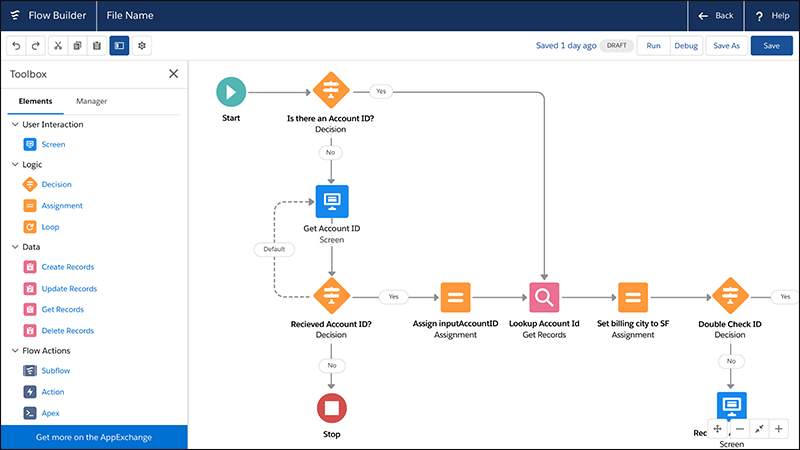Excellent Facts To Choosing Legacy application modernization with Low-code
Excellent Facts To Choosing Legacy application modernization with Low-code
Blog Article
Advantages Of Low-Code Application Development In Terms Of Integration Capabilities
Low-code apps offer a lot of benefits for integration, which is essential when creating applications that are able to seamlessly connect various systems and service. Here are a few of the main advantages: Prebuilt Connectors and APIs
Wide Selection of Connectors. Low-code systems usually include a wide range of pre-built connections for the enterprise system that are widely used (e.g. cloud-based services, databases, CRM). The process of integrating these systems is made easier.
API Integration: Many Low-Code platforms come with out-of-box API integration tools that allow developers to effortlessly connect external services as well as data resources.
Simple to Utilize:
Drag-and-Drop Integration integration tasks can usually be done using drag-and drop interfaces, which makes it easy for both developers and non-developers to design complex integrations, without writing lots of code.
Visual Workflow Builders Visual tools to design workflows and data flows aid in understanding and setting up integrations more easily.
Standardized Integration Methods:
SOAP and restful services: Supporting web-based services common protocols such as REST or SOAP allows integration with a many different platforms and systems.
OData Standards and other Standards Support for standards, like OData permits easy access to data as well as its manipulation across different platforms and applications.
Real-Time Data Synchronization:
Real-Time Integrations: Low-code platforms are able to handle real-time synchronization of data between applications, systems and databases. This ensures that data is up-to-date and consistent within an company.
Event-Driven Architecture: Certain platforms can support event-driven architectures. permitting applications to respond to events in real-time, which is essential for dynamic and interactive applications.
Legacy System Integration:
Connecting old Systems and new Systems Low-code platforms typically provide the tools needed to integrate with legacy systems. This allows organisations to modernize their IT Infrastructure without re-designing their current systems.
Data Migration Tool: Built-in migration tools permit data to be transferred from older systems into new applications which are built on low code platforms.
Third-Party Integration of Service:
Cloud Services: Seamless Integration with Cloud Services such as AWS Azure Google Cloud and Google Cloud makes it easy to deploy applications.
Business Applications Integration: Low code platforms are able to be integrated with other business applications such as Salesforce, SAP and Microsoft Dynamics. This facilitates seamless flow between different business processes.
Simple Data Management
Unified Data Models: Some low-code platforms have unification of data models that simplifies data management and integrating between various systems.
Data Connectors Data connectors that are pre-configured make it easy to access and manipulate data from many sources.
Security and Compliance
Low-code integration platforms meet security standards to protect data while in transit or at rest.
Security Features: These platforms usually contain features that ensure the integrations are compliant with the requirements of regulatory agencies (e.g. GDPR, HIPAA), providing security for companies handling sensitive data.
Extensibility:
Low-code platforms permit the use of custom scripts and codes to satisfy more complicated integration requirements. The flexibility provided without compromising the ease of use.
Plug-in Ecosystems. A community of plug-ins and extensions will allow you to further enhance the capabilities of integration, while adding new features whenever you need to.
Overall, the low-code platform's capabilities for integration make it a powerful instrument to create interconnected applications which are scalable and efficient. They allow you to connect various systems. They also enhance the flow of data. Check out the recommended a knockout post for site recommendations including cross platform mobile app development, azure sql, lowcode no code, cloud software applications, cloud software applications, software for app development, build with docker, azure sql server, app development platform, low code platforms and more.
Benefits Of Low-Code Application Development In Terms Of Flexibility And Scalability
Low-code development has several benefits in terms of flexibility and scalability that are essential for creating applications that are able to grow and adapt with changing business requirements. Three benefits are listed below.
Cloud-based deployment: Many lowcode applications are built on cloud computing, which allows applications to scale up with the infrastructure. This allows businesses to manage growing demands without having to worry about managing servers.
Auto-Scaling Features - Built-in automatic scaling features automatically adjust resources in accordance with the demand. This allows for consistent performance even in peak times without manual intervention.
Flexible Architecture:
Modular Design: Low-code platforms encourage modular design of applications, in which components can be independently developed as well as tested and scaled. This is a fantastic way to enhance flexibility. It is also easy to update and expand parts of a system without having the whole application affected.
Microservices Integrate: They allow applications to expand and be adaptable by allowing them to be designed as a set of interconnected services.
Customizable Solutions
Flexibility : Low-code platforms allow developers to extend functions beyond what they are able to provide. This guarantees that specific business needs can be fulfilled without constraints.
Third-Party Integrations: The ability to connect with third-party services and APIs permits companies to integrate additional features and services as needed and enhance the capabilities of the application.
Agile Development and deployment:
Continuous Delivery and Deployment Low-code platforms are able to support agile methodologies which allow continuous integration as well as continuous delivery (CI/CD). This enables rapid deployment of updates and the introduction of new features, allowing apps to develop rapidly in response to the feedback of users and changes in the market.
Iterative development Iterative development: Low-code development is iterative meaning that applications can be scaled and developed in a gradual manner. This minimizes the chance of major changes and allows the growth to be controlled.
Resource Optimization
Efficient Resources Management: Low Code platforms can optimize resource usage through tools that track and control the performance of applications. This enables resources to be utilized efficiently and also to be sized up or down depending on the needs.
Load Balancing: Integrated load balancing features distribute workloads equally across servers, increasing the capacity of applications to handle heavy traffic and ensure consistency in performance.
Global Reach
Multi-Region Deployment: Low-code systems typically support deployment across several geographic regions, enabling businesses to provide low-latency access to users across the globe. This is essential, especially for applications with global users.
Support for Localization. Built-in support to localize applications makes them easily adapted to different languages, regional demands and improves their flexibility in different markets.
Maintenance and updates
Simplified maintenance: The graphic and module design of low-code applications makes it easier to complete the maintenance chores. They permit updates and bug corrections to be carried out quickly without lengthy downtime.
Version Control Systems for Version Control assist in managing rollbacks and changes, ensuring that updates can be deployed without risk and that previous versions are restored when required.
Cost Efficiency:
Reduced Development Costs: Low-code platforms enable a reduction of the development costs by removing the need to code in depth. This enables applications to be scaled without an increasing costs or development time.
Pay-As.-You-Go A lot of lowcode platforms have flexible pricing models, including pay-as.-you-go. These models align prices with usage and growth, allowing financial flexibility.
In general, low-code app developers provide a high degree of scalability and flexibility that allows companies to rapidly build robust and flexible apps. These platforms provide quick responses to changing requirements, resource efficiency, and continual improvements, making it possible for applications to grow with a business. View the recommended Legacy application modernization with Low-code for more advice including rapid app development, multiplatform mobile app development, app modernisation, application development platforms, develop web app, jdbc server, develop mobile application, rad application development, rapid application design, ms azure sql and more.
The Benefits Of Developing Applications Using Low-Code For Collaboration And Workflow
Low-code development offers many benefits for collaboration and workflow. This makes it an ideal option for companies looking to increase productivity and speed up the development process. Here are some of the main benefits: Improved cross-functional collaboration:
Unified Development Environment. Low-code platforms enable all team members to work in a single and unifying environment. This includes business analysts, developers and designers as well as stakeholder. This eliminates silos and promotes better communication.
Visual Development Tools - The drag-and drop visual nature of low code platforms allows people who are not technical to participate easily in the process. This ensures that all business requirements are identified and accurately implemented.
Advanced Communication
Real-Time Collaboration Many low-code applications have real-time features such as editing and commenting simultaneously or immediate feedback. This enables continuous communication, and helps to reduce the amount of time wasted in a back and forth discussion.
Shared workspaces. Teams are able to collaborate through shared workspaces. In this workspace, they can review, edit, and discuss various project components.
Workflow management streamlined:
Built-in tools for managing projects Lowcode platforms usually come equipped with integrated tools that aid teams in planning, tracking and managing their development. This includes assignment of tasks, tracking progress as well as deadline management.
Workflow automation: The automation of routine tasks, workflows, and other processes decreases the manual effort required and eliminates mistakes. This allows teams to concentrate on tasks that are more profitable and improves efficiency.
More Rapid Iteration:
Rapid prototyping: Low code platforms permit rapid prototyping as well as iterative development and rapid prototyping. This allows teams to develop applications that are tested, then refine them in shorter cycles. This means that feedback can be quickly integrated and improvements implemented quickly.
Agile Development Support : Support for agile methodologies allows team members to be involved in sprints. They can continue to deliver small increments in functionality, and more easily adapt to changes in requirements.
Accessibility:
Citizen-driven development platforms enable business users to modify and develop applications with no programming expertise. This eases the burden on IT and development teams and can provide faster responses to business requirements.
Onboarding and Training. The simple interfaces of the training tools make it easy for the new members to get acquainted with the system and this helps improve collaboration.
Centralized documentation and sharing of knowledge
Documentation integrated: Low-code platform features often permit you to make and manage documents inside the platform. The entire project's information is centrally accessible and easy to access.
Knowledge Repositories: Teams can create knowledge repositories, which contain templates, best practices and reused components. This facilitates knowledge sharing and minimizes the need for duplicate efforts.
Consistency and Standardization
Standardized Components. The use of pre-built standard components provides consistency throughout all software. This makes it easier for team members to learn and collaborate with various parts of projects.
Compliance and governance Frameworks built-in for governance ensure that applications are created in line with the organizational standards, regulations requirements, and quality standards. They minimize the chance of not being compliant and ensure that the applications are compliant with standards.
Feedback Loops and Improvement Loops
Integrated Feedback Systems: Low-code platforms have integrated feedback systems that enable users to give feedback about the application. The feedback could later be used to improve the design of the applications.
Continuous Improvement - The ability to rapidly iterate, deploy and change applications based on user feedback helps them align with the business objectives and user demands.
Visualization, Reporting and Analysis
Real-time analytics The built-in analytical and reporting features provide real-time insights about project progress, performances and user interaction. They allow data-driven, informed decision-making.
Visual Workflow Maps Software to map workflows or processes are helpful to teams in understanding their processes. They also help to identify the bottlenecks that are present, as well as areas that require improvement.
Low-code apps offer a variety of benefits for collaboration and workflow. It is able to bring teams from different backgrounds into one space, simplify communication, and automate certain processes. This creates a collaborative, agile and efficient development environment, which leads to more efficient and high-quality applications.